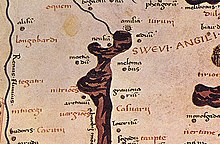Aliso (place name)
The Aliso called in Latin Alisum ( Greek Ἄλισον Aleison or "Eleison") is a place name, which in the Geographia of Claudius Ptolemaios (2, 11, 14) as one of the places in the interior of Germania (πόλεις) with 28 ° 00 'longitude (Ptolemaic longitudes) and 51 ° 30 'latitude. According to Ptolemy, Aliso is close to the ancient place Boudoris in Germania magna. Because of the age of the spring, the age of the settlement can be assumed to be around 150 AD.
The Roman fort Aliso
The place name Aliso is passed down in ancient literature by Velleius Paterculus and Tacitus ; Ptolemy is very likely to refer to this place name with Alisum .
Without mentioning the place name, Cassius Dio reports of a Roman fort that Drusus is said to have built at the confluence of the rivers Lippe and Elison. Hans Kuhn assumes that Dios Ort corresponds to the Aliso of the ancient authors mentioned above. Without giving the place name, Dio and Frontinus also report events that may have occurred in Aliso.
According to Hans Krahe, the name Aliso is related to a very common old European water name. The frequent occurrence of the name makes it difficult to locate the Roman fort. The research does not rely on the Ptolemaic coordinates here, especially since it has not been proven that Ptolemy specified the fort. Toponymic research on current river or place names has so far not been successful.
Historical research now assumes that Elison in Cassius Dio's description is not the Roman fort Aliso . In the search for a Roman military camp on the Lippe , the Oberaden Roman camp was discovered, of which it is now assumed that Cassius Dio wrote about it in his report.
localization
The actual location of the place has not yet been clarified. An interdisciplinary research team led by Andreas Kleineberg, who re-examined and interpreted the Ptolemaic coordinates from 2006 to 2009, is currently locating Aliso in the area near Bergisch Gladbach in North Rhine-Westphalia . Recent finds and excavations in 2014 and 2015 have shown that the city was settled and used for industry as early as the 1st and 2nd centuries AD. Roman lime kilns were found that can be assigned to this period.
Ancient sources
- Velleius Paterculus , Roman History 2,120,4.
- Tacitus , Annales 2,7,3.
- Ptolemy , Geographia 2,11,14.
Remarks
- ^ A b cf. Hans Kuhn , Wilhelm Schleiermacher: Aliso. In: Reallexikon der Germanischen Altertumskunde (RGA). 2nd Edition. Volume 1, Walter de Gruyter, Berlin / New York 1973, ISBN 3-11-004489-7 , pp. 170-171. ( chargeable via GAO , De Gruyter Online)
- ^ Cassius Dio , Roman History 54,32,3.
- ↑ Hans Kuhn assumes that river names and place names generally correspond. See Hans Kuhn , Wilhelm Schleiermacher: Aliso. In: Reallexikon der Germanischen Altertumskunde (RGA). 2nd Edition. Volume 1, Walter de Gruyter, Berlin / New York 1973, ISBN 3-11-004489-7 , pp. 170-171. ( chargeable via GAO , De Gruyter Online)
- ↑ Cassius Dio, Roman History 56,22,2.
- ^ Sextus Iulius Frontinus , Strategemata 3, 15, 4 and 4, 7, 8.
- ↑ Hans Krahe: Our oldest river names . O. Harrassowitz, Wiesbaden 1964, p. 110.
- ↑ The Aliso camp. In: Clades Variana. Albert Bömer, accessed August 18, 2016 .
- ^ Archeology in Bergisch Gladbach: Roman bricks pose a riddle. Accessed June 23, 2016 (German).
literature
- Hans Kuhn , Wilhelm Schleiermacher: Aliso. In: Reallexikon der Germanischen Altertumskunde (RGA). 2nd Edition. Volume 1, Walter de Gruyter, Berlin / New York 1973, ISBN 3-11-004489-7 , pp. 170-171. ( chargeable via GAO , De Gruyter Online)
- Max Him : Aliso 1 . In: Paulys Realencyclopadie der classischen Antiquity Science (RE). Volume I, 2, Stuttgart 1894, Col. 1496 f.
- Hermann Reichert : Ptolemaeus. In: Reallexikon der Germanischen Altertumskunde (RGA). 2nd Edition. Volume 23, Walter de Gruyter, Berlin / New York 2003, ISBN 3-11-017535-5 , pp. 567-597. ( chargeable via GAO , De Gruyter Online)
- Alfred Stückelberger, Gerd Graßhoff (ed.): Ptolemaios, Handbook of Geography (Greek-German) . Schwabe Verlag, Basel 2006, ISBN 3-7965-2148-7 (work in 2 half-volumes, with CD-ROM).
- Corinna Scheungraber, Friedrich E. Grünzweig: The old Germanic toponyms as well as non-Germanic toponyms of Germania. A handbook on its etymology using a bibliography by Robert Nedoma. Published by Hermann Reichert (= Philologica Germanica 34). Fassbaender, Vienna 2014, ISBN 978-3-902575-62-3 , pp. 254-255.
Web links
- Edition of Geographike Hyphegesis with translation and map of Germania magna , accessed on November 15, 2016.
- Google Earth in ancient times. In: Der Spiegel. 39/2010, accessed November 15, 2016
